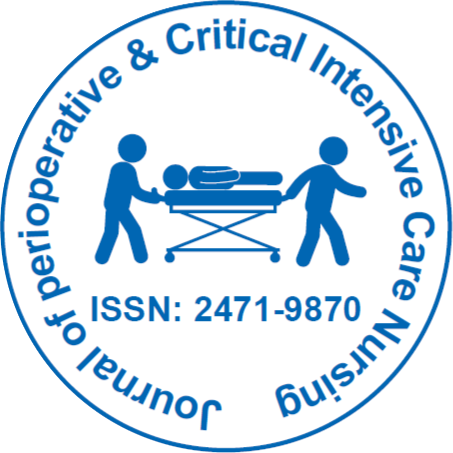
Journal of Perioperative & Critical Intensive Care Nursing
Open Access
ISSN: 2471-9870

ISSN: 2471-9870
Opinion - (2022)Volume 8, Issue 4
The current global spread of COVID-19, a highly infectious disease, has put enormous strain on healthcare systems and medical personnel around the world. Overburdened critical care units have had to deal with a shortage of beds, specialised staff, and medical supplies due to a dramatic rise in the number of newly reported cases and the rapid progression of the disease into a critically ill state. As a result, temporary intensive care units (ICUs) were set up in isolated hospitals to provide the centralised care that all serious cases demanded. From the identification of critically ill COVID-19 patients to the arranging and equipping of the unit, as well as providing training, the authors' experience in setting up and managing such an ICU in Wuhan, Hubei Province, China, is mentioned in this paper [1].
Acute hypoxemic respiratory failure is the most common COVID19 complication. Hypoxemia has a variety of causes, including pulmonary edoema, vascular microthrombosis, and poor ventilation/perfusion (V/Q). The aim should be to keep your oxygen saturation between 92 and 96 percent. It's likely that in most patients, supplemental oxygen is only needed at low flows (nasal cannula, simple mask, or mask with reservoir). Patients with rapid and gradual deterioration pose a risk, as the use of techniques including a high-flow nasal cannula (HFNC), noninvasive mechanical ventilation (NIMV), and early intubation is debatable. With the exponential rise in COVID19 incidents, health facilities are overburdened and unable to provide sufficient treatment. This has had a significant effect on the percentage of critically ill patients who die. As a result, each ICU must adapt and improve care protocols for critically ill COVID-19 patients based on its own needs and resources. There is an increasingly growing body of information about COVID19 care. To date, clinical evidence supports the use of remdesivir as an antiviral; it should be initiated during the viremic process, and it is preferred for patients who are hospitalised and receiving oxygen to avoid further deterioration. It is recommended that in serious and critical situations, low corticosteroid doses and LMWH be started as soon as possible [2].
The protection of supportive care interventions such as oxygen by high-flow nasal cannula and noninvasive ventilation are unclear, and even among seriously ill patients, the risk of mortality is unknown. There are no known treatment methods that have been shown to be successful, and the risk-benefit ratio for widely used treatments like corticosteroids is unknown. Observational research and clinical trials across a wide variety of patient groups and care environments are important for understanding as much as possible. This should provide precise measurements of critical illness severity so that outcomes can be risk-adjusted, as well as a sufficient number of similar outcome indicators to allow data to be combined and validly compared across regions. Clinical trials can preferably be designed to optimise global learning, such as through the use of master protocols or adaptive platform designs.Another emerging virus has posed a serious threat to health care facilities and society in a very short period of time. The primary objectives are to prevent transmission and delay the spread of new infections; however, the fear of COVID-19 causing critical illness and death is at the forefront of public concern. Every year, the critical care community treats a significant number of serious acute respiratory infections, many of which have unknown causes. The basis for the treatment of COVID-19 patients who are critically ill must be based on this evidence base, while also ensuring that the learning from each patient is maximised to support those who will come after them [3].
REFERENCES
1. Peng M, Qian Z, Zhang L. Care for Critical Ill Patients with COVID-19: Establishment of a Temporary Intensive Care Unit in an Isolated Hospital. Front Med. 2020;7:519.
2. Gutiérrez Zarate D, Rosas Sánchez K, Flores Carrillo JC, Medrano Ahumada S, Martínez Franco M. Early management of critically ill patients with COVID 19. 2020;1:1418-1426.
3. Murthy S, Gomersall CD, Fowler RA. Care for critically ill patients with COVID-19. Jama. 2020;323(15):1499-1500.
Citation: Jansson K (2022) An Overview on Critical Care Nurses: Challenges & Workload. J Perioper Crit Intensive Care Nurs 8: 209.
Received: 22-Dec-0022, Manuscript No. JPCIC-22-21442; Editor assigned: 25-Nov-2022, Pre QC No. JPCIC-22-21442 (PQ); Reviewed: 09-Dec-2022, QC No. JPCIC-22-21442; Revised: 16-Dec-2022, Manuscript No. JPCIC-22-21442 (R); Published: 23-Dec-2022 , DOI: 10.35248/2471-9870.21.7.170
Copyright: © 2022 Jansson K. This is an open-access article distributed under the terms of the Creative Commons Attribution License, which permits unrestricted use, distribution, and reproduction in any medium, provided the original author and source are credited.